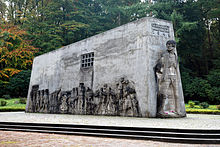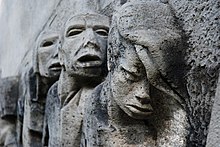Karel Niestrath
Karel Niestrath (* 1896 in Salzuflen ; † 1971 in Hagen ) was the sculptor from Hagen who created reliefs and sculptures at the Bittermark Memorial in Dortmund to commemorate the murdered forced laborers and resistance fighters who were murdered on the days before the American troops marched into Dortmund .
Niestrath began his artistic career with an apprenticeship as a sculptor. Returning from the First World War injured in 1917 , he studied at the Werkkunstschule Bielefeld . He later continued his studies at the Dresden Art Academy . Niestrath's work was shaped by the experience of the First World War, which he represented in sculptures and watercolors. In addition, he created works on the topics of pregnancy and childbirth as well as various portraits.
In 1933 his work Kriegskrüppel was shown as a photo in the Nazi exhibition Degenerate Art , his works were subsequently banned from museums and the public. In 2008, the Westphalian State Museum in Münster showed Niestrath's sculpture Die Hungrige among 44 exhibits that had been removed as "degenerate art" during the Nazi dictatorship .
After the Second World War, Niestrath was initially a teacher at the painting school founded by Hans Tombrock in Dortmund in 1947 , and later a lecturer at the Werkkunstschule Dortmund . One of his students was the Dortmund sculptor Anselm Treese . A relief on the mourning hall of the cemetery in Hagen-Haspe was one of his first works after the war. In 1960 he designed large-scale sculptures and reliefs for the Dortmund memorial in the Bittermark. Niestrath uses different styles and forms to depict the suffering of the brutally murdered slave laborers and resistance fighters. Almost cubist, angular shapes characterize the Nazi murderers, various sculptures and reliefs show the torture of the almost 300 murdered victims. Christian motifs, the crucified Christ, contrast with the Nazi perpetrators, who were depicted as sun worshipers.
“In doing so, he made use of daring, not even everyday artistic means: the emaciated, battered figures, the victims, are provided with realistic features, carved into expressive organic shapes - the murderers appear in the truest sense of the word faceless and heartless, as unsubstantial robots in a geometrically abstract garment. ”(Günther Ott: The sculptor Karel Niestrath. p. 15)
literature
- Günther Ott: The sculptor Karel Niestrath. In: Up. Youth magazine of the German Trade Union Federation, No. 10, Volume 13, October 15, 1960, pp. 15-17.
- Hans Friesen (ed.); Hans Gerber (author), Jürgen Thormählen (author), Michael Eckhoff (author), Claus U Derichs (author), Petra Holtmann (author), Jens Bergmann (author), Holtmann (ed.); Jörg Ludwig (photographer): HagenKunst, art in public space . ardenkuverlag, 2006, ISBN 3-932070-08-9 .
Exhibitions
- Museum am Ostwall Dortmund, exhibition catalog 1973.
- Karl Ernst Osthaus Museum May 27, 1994 to August 7, 1994
- Galerie Remmert and Barth, several works in overview exhibitions
Web links
| personal data | |
|---|---|
| SURNAME | Niestrath, Karel |
| BRIEF DESCRIPTION | German sculptor |
| DATE OF BIRTH | 1896 |
| PLACE OF BIRTH | Salzuflen |
| DATE OF DEATH | 1971 |
| Place of death | Hagen |




